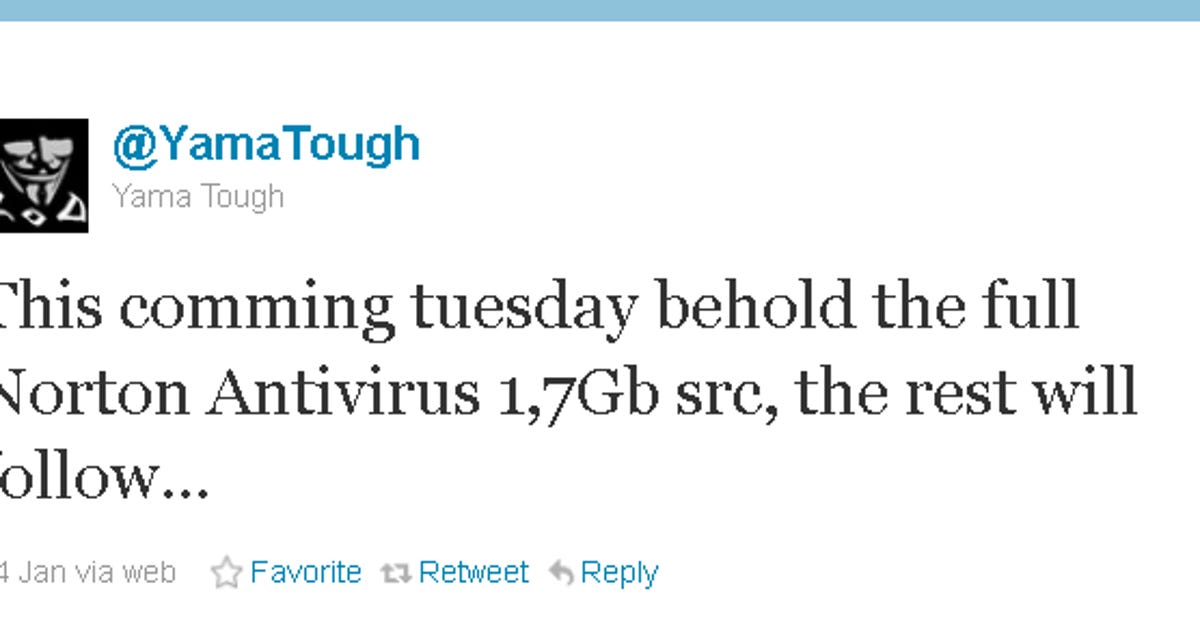
Hackers threaten to release Symantec source code Tuesday
Hackers thought to have stolen source code from the Symantec's extended network have threatened to release the source code for Norton Antivirus on Tuesday, but the company says such a release poses no threat.
The hackers, who call themselves "Yama Tough" and employ the "Anonymous" mask in its Twitter avatar, said in a tweet Saturday that they would release the 1.7GB source code on Tuesday. "The rest will follow...," they added.
Several reports surfaced earlier this month that hackers had managed to access the source code for certain Symantec products. Symantec identified the products as Symantec Endpoint Protection (SEP) 11.0 and Symantec Antivirus 10.2, but said the attack did not affect any current Norton consumer products.
The hackers said they found the code after breaking into servers run by Indian military intelligence. The code was apparently left on the servers by mistake after Indian authorities inspected the source code to ensure it was secure. And that's where the hackers found the code.
The group said in a Pastebin post that it had the "source codes of dozens of companies" and contained documentation describing the API procedures for Symantec's virus definition generation service. The group's post on the Pastebin site has since been removed, though a Google cached version still exists.
Symantec said in a statement to CNET sister site ZDNet that code posted to Pastebin was related to a 2006 version and is "no longer sold or supported."
"The current version of Norton Utilities has been completely rebuilt and shares no common code with Norton Utilities 2006. The code that has been posted for the 2006 version poses no security threat to users of the current version of Norton Utilities," the company said in a statement.
Rob Rachwald, director of security strategy at Imperva, wrote in a blog post that the incident was "embarrassing on Symantec's part" but not likely to "keep the Symantec folks awake too late at night, and certainly not their customers."
If the source code had been recent and the hackers were able to poke enough holes in it, then exploiting the software could be possible, noted Rachwald. But there's not much they can learn from old code.
Source
Tags:
- What Happened To Symantec
- Symantec Agent Latest Version
- Symantec Security Threat Report
- Symantec Network Threat Protection
- Symantec Internet Security Threat Report 2019
- Symantec Advanced Threat Protection
- Hacker Threatening To Release Video
- Hackers Movie Release Date
- Hackers Threat Crossword Clue

9 great reads from CNET this week: Tech fails, NFTs, Marvel and more
Every year has its ups and downs. The ups are a thrill. The downs are often fascinating, for what they reveal about the limits of our ambitions, the challenges of trying to get things right and the escape hatches that might get us out of trouble (or the rabbit holes that take us ever deeper).
Or just because misery loves company. At this time of year, we regularly take a look back at the craziness that unfolded in the world of technology. There were notable slipups and outbreaks of weirdness, which CNET news chief Roger Cheng has chronicled in his wrapup story; I particularly liked his use of the term "an iceberg of terrible" in describing all the trouble that accumulated around Facebook/Meta in 2021.
That story is among the many in-depth features and thought-provoking commentaries that appeared on CNET this week. So here you go. These are the stories you don't want to miss.
Commentary: This year included more vaccine misinformation, random internet outages and yet another T-Mobile data breach.

"I could just right click and save that NFT" isn't an argument anymore.

Commentary: I'll never again take safety technology for granted.

Parag Agrawal, the new CEO, will have his hands full.

Disney Plus became indispensable entertainment this year, with WandaVision, The Falcon and the Winter Soldier, Loki, What If...? and Hawkeye appearing at a steady clip.

Critics fear new tools to help those struggling with body image are just a drop in the bucket.

If someone asks for payment in the form of a gift card, just say no.

Our work and our lives may never return to a pre-pandemic normal, and that's caused some major shifts in where people are choosing to live in the US.

Gigi Sohn, a longtime consumer advocate and former FCC official, faced Republican opposition at her Senate confirmation hearing.

Source
Tags:
- Most Read Books This Week
- Top 10 Reads 2019
- Five Great Weekend Reads
- What To Read This Weekend
- Cnet 9 Great Reads
- Top 10 Reads 2019
- Great Book To Read
- Grade 9 Reading Books
- G rade 9 Books To Read
- 9 Great Castle Hotels In Europe
- 9 Great Stuart Street Edinburgh

What Is Shrinkflation and What Does It Mean for Your Favorite Supermarket Items?
Higher grocery bills continue to plague American consumers, as the Consumer Price Index for May shows that the "food at home index" was up another 1% in May. Food prices in April were already up 10.8% from where they were a year ago, the largest 12-month increase since November 1980, according to the Bureau of Labor Statistics.
It's not just consumers, though: Manufacturers are feeling the pinch of inflation as well, with ingredients costing more and supply chain issues making it harder to get goods to store shelves.
Rather than just raise prices, some manufacturers shrink their packaging, a practice known as "shrinkflation."
Shoppers across the US have reported smaller toilet paper rolls, fewer potato chips and other reductions in supermarket staples.
"It comes in waves," consumer advocate Edgar Dworsky told NPR. "We happen to be in a tidal wave at the moment because of inflation."
Read on to learn more about shrinkflation, including whether it's legal, how to guard against it and which manufacturers are downsizing their products.
What does "shrinkflation" mean?
Shrinkflation is the practice of reducing the size or quantity of a product while keeping the same price. It can mean fewer chips in the bag, fewer scoops of ice cream in the container. Basically, the purchase price remains the same but the cost per unit rises.
Customers may not notice what are effectively price increases, John Gourville, a professor of business administration at the Harvard Business School. "We found that consumers reacted greatly to periodic changes in price, but not at all to periodic (yet systematic) reductions in quantity," Gourville said in an interview back in 2004.
Some companies disguise shrinkflation with a package redesign, according to Gourville, like adding dents to the bottom of bottles or touting claims of "lower calories."
A Gatorade representative told Quartz in March that the company redesigned its bottles to be "more aerodynamic" and "easier to grab." It also happened to reduce the amount of Gatorade in the container from 32 to 28 ounces.
Is shrinkflation legal?
Shrinking package size is not illegal so long as the product amounts are clearly labeled and "and the business is not engaging in unfair or deceptive practices," according to the Massachusetts Office of Consumer Affairs.
"This is legal -- companies can change prices of their products however they want. This way they do it and it reduces the amount of complaints that the companies receive as a consequence of this stuff," Tom Fullerton, an economics professor at the University of Texas at El Paso, told KFOX.
How can I protect myself against shrinkflation?
Consumers tend to pay more attention to product prices than package sizes. Breaking that habit is the top tip for steeling yourself against shrinkflation: learn the package sizes and per-unit pricing for your favorite products.
If you notice that a product has shrunk or reduced the number of included items, consider competitors who offer a similar product at a lower cost per ounce or item. Compare per-unit prices to see which product provides a better deal.

Charmin has reportedly reduced the amount of toilet paper in its Mega package from 266 sheets per roll to 244.
Olivier Douliery/Getty ImagesShrinkflation also offers an opportunity to wean yourself off packaged foods. Retailers might be able to make cereal boxes and granola bars smaller, but they can't shrink a pound of apples.
Dworsky, the consumer advocate, has made shrinkflation (or "downsizing," as he calls it) a major focus of his website MousePrint, which is dedicated to examining the fine print of advertising claims.
Every few months, Dworsky publishescompilations of all the products he's found that have recently decreased in size. He usually posts on Mondays and crowdsources items from his readers to get a fuller picture of which products have changed.
The Reddit message board /r/shrinkflation also serves as a good source for tracking package size changes for your favorite products. Users post instances of shrinkflation that they've found in their local stores or online, usually with screenshots or photos as evidence.
Which products have shrunk?
Consumers have reported shrinkage in all kinds of household products. A keen eye on Reddit found that Huggies Little Snugglers packs dropped from 96 diapers per box to 84.
Procter & Gamble's Cascade reduced the number of dishwashing pods in a box from 78 to 63, while Unilever's Seventh Generation liquid dish soap dropped from 25 to 19 ounces with a bottle redesign.
Charmin has shrunk its Super Mega package from 396 double-ply sheets per roll to 366, MousePrint reported. The toiler paper company also reduced its Mega package from 266 sheets per roll to 244.
Cottonelle reduced the number of toilet paper sheets in its Ultra Clean line from 340 sheets to 312 and in its Ultra Comfort brand from 284 sheets to 268.

Other bath products have also gotten smaller: Pantene has rebranded its Curl Protection Conditioner and in the process reduced the size from 12 to 10.4 ounces, per Reddit. And MousePrint reports that Dove Body Wash recently shrunk from 24 to 22 ounces.
Snacks are another popular target for shrinkflation, as they often come in bags that make it difficult to spot changes. Last year, Doritos decreased the weight of its regular-size bags from 9.75 to 9.25 ounces, a loss of about five chips per bag. Redditors also noticed that Doritos' party-size bag has shrunk from 15.5 to 14.5 ounces.
A party-size bag of Fritos Scoops, which used to be 18 ounces, is now reportedly just under 16 ounces, the Associated Press reported. A tube of Pringles now carries 165 grams of potato chips, down from 200 grams.
Nabisco's Wheat Thins made its "Family Size" product smaller, too, lowering the package weight from 16 to 14 ounces, per Reddit.
A bag of Keebler's Vienna Fingers bag has shrunk from 14.2 to 12 ounces, per Reddit. And MousePrint reports that the size of the company's regular Chips Deluxe package dwindled from 11.3 to 9.7 ounces. (The "family size" package decreased from 17.2 to 14.6 ounces.)
Package downsizing has also hit fast-food chains: Domino's has cut down the number of boneless wings in an order from ten to eight, citing "unprecedented ingredient costs." Burger King is doing the same with its chicken nuggets.
And Subway rotisserie chicken wraps and sandwiches now contain less meat, Bloomberg reported.
Source
Tags:
- What Is Shrinkflation Ethical
- What Is A Gamecock
- What Is Rsv
- What Is An Nft
- What Is My Ip
- What Is Normal Blood Pressure
- What Is The Difference
- What Is Gout
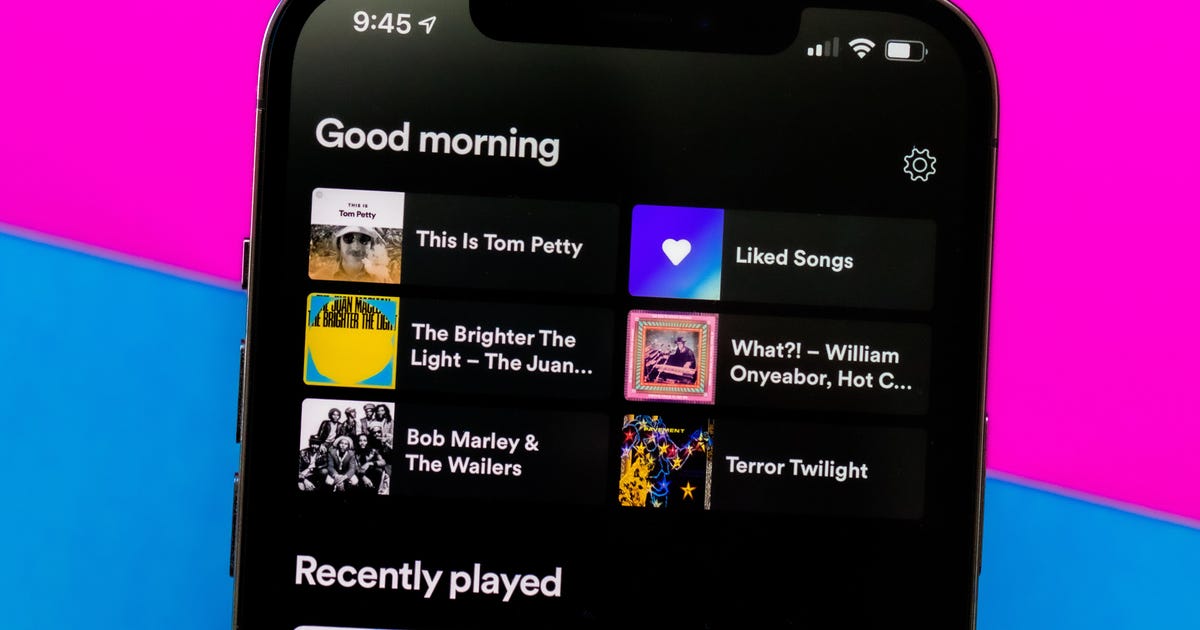
3 Spotify Audio Settings That All 188 Million Subscribers Should Probably Change
With over 188 million subscribers worldwide as of this month, Spotify is arguably one of the most popular music streaming platforms in the world. CNET also ranks Spotify as one of the best music streaming services on the market.
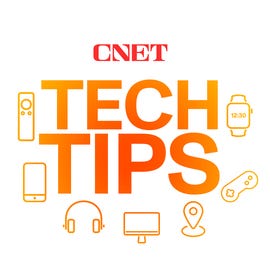
Spotify lets you listen to music wherever you are, recommends new songs based on your activity and provides fun, personalized streaming data at the end of every year. Paid subscribers can also make and share playlists with friends on social media, or with the whole world through the app.
Read more: Best Soundbar Under $300
If you feel like something is missing from your listening experience though, Spotify lets you take control of various settings to make your music sound more superb. That way whether you're in a quiet library, your morning commute or pumping some iron in the gym, your music will always fit the mood.
Here's how to crank your Spotify listening experience up to 11 no matter what the situation.
Adjust your base volume to match your environment
Volume is pretty easy to figure out, but did you know Spotify lets premium users adjust the base volume of the app depending on their environment? You can select either Quiet, Normal or Loud, and each has its own benefit.
Quiet will make songs a little quieter and sound cleaner, making it a good choice if you're relaxing at home. Normal makes songs play at a medium base volume, and the sound is less crisp than Quiet. This is a good choice for most people and situations. Loud is -- you guessed it -- louder, but you might lose some audio quality because of the loudness. This option is good if you're at the gym or other similarly noisy environments.
Here's how to adjust the base volume on your iPhone:
1. Open the Spotify app.
2. Tap the gear icon in the top-right corner of your screen.
3. Tap the Playback option near the top of the menu.
4. Beneath Volume level there are three options: Loud, Normal and Quiet.
If you're using the Spotify app on a Mac, here's how to adjust the base volume:
1. Open Spotify.
2. Click the down arrow in the top-right corner.
3. Scroll down until you see Audio Quality.
4. Under Audio Quality, you should see Volume level.
5. Click the drop-down bar to the right of Volume level.
6. From here, you see the same Loud, Normal and Quiet options. Pick whichever one works for you.
Here's how to adjust the base volume if you're using the Spotify app on an Android device:
1. Open Spotify.
2. Tap the gear icon to access Settings.
3. Scroll down to Playback and you should see Volume Level.
4. Next to Volume Level you should see the Loud, Normal and Quiet options. Pick the one you want.
Finally, here's how to adjust the base volume in Spotify while on a Windows computer:
1. Open Spotify.
2. Click your account name in the top-right corner.
3. Click Settings.
4. Under Audio Quality, you should see Volume level. Click the drop-down bar to the right.
5. Select either Loud, Normal or Quiet.
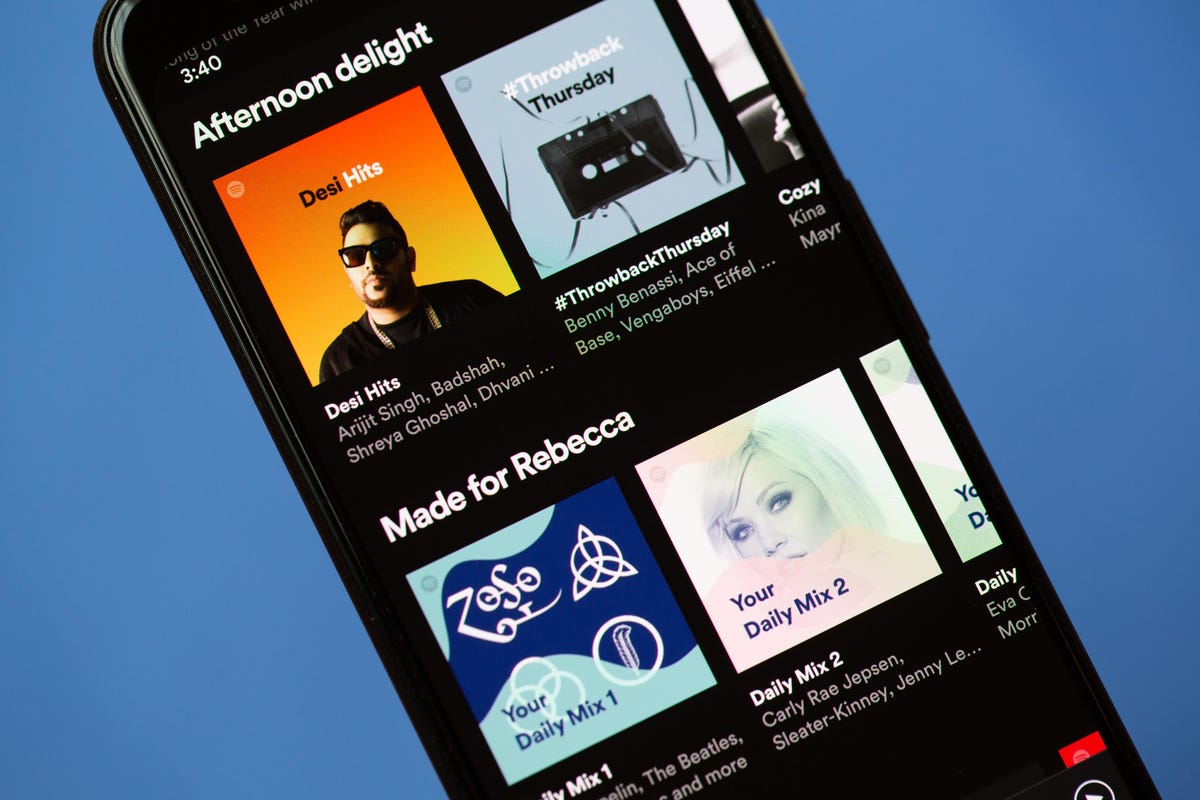
Use the equalizer to customize your sound for your favorite genres.
Angela Lang/CNETUse the Spotify Equalizer for more control
If you prefer being more hands-on with how your bass and treble come across in each song, you can adjust the in-app equalizer. Adjusting your bass affects lower frequency sounds, making your music sound deeper with increased bass or flat with less bass. Treble affects the higher sound frequencies, making your music sound brighter and more crisp with increased treble or duller and kind of muddied with less treble.
Here's how to access the equalizer on your iPhone:
1. Open Spotify.
2. Tap the gear in the top right corner to access Settings.
3. Tap the Playback option.
4. Scroll down the menu and tap Equalizer.
Here's how to access the equalizer on your Android device:
1. Open Spotify.
2. Tap the gear icon to access Settings.
3. Under the Audio quality heading -- not under Data Saver -- tap Equalizer.
This opens the equalizer page on both systems. Here you can find the manual equalizer slider and a handful of premade genre-based equalizers.
You should see the manual equalizer slider that looks like a line graph with six dots. When you first get to this page, the equalizer should be flat.
Each dot on the graph can be adjusted for more or less sound. The far left bar represents your bass, the far right bar controls your treble and the middle bars control -- you guessed it -- your midrange. You can tweak the bars as you see fit.
There are also genre-based equalizers on this page. You can pick which genre you're listening to and the app automatically adjusts the sliders to optimize for that style of music. After picking one, you can further adjust the sliders for the perfect listening experience.
If you want to reset the equalizer, there's a genre-based equalizer called Flat. This will reset the equalizer to its default.
The Mac and Windows versions of Spotify don't have an in-application equalizer. But you can search for an equalizer application to help you in your journey to find the best sound.
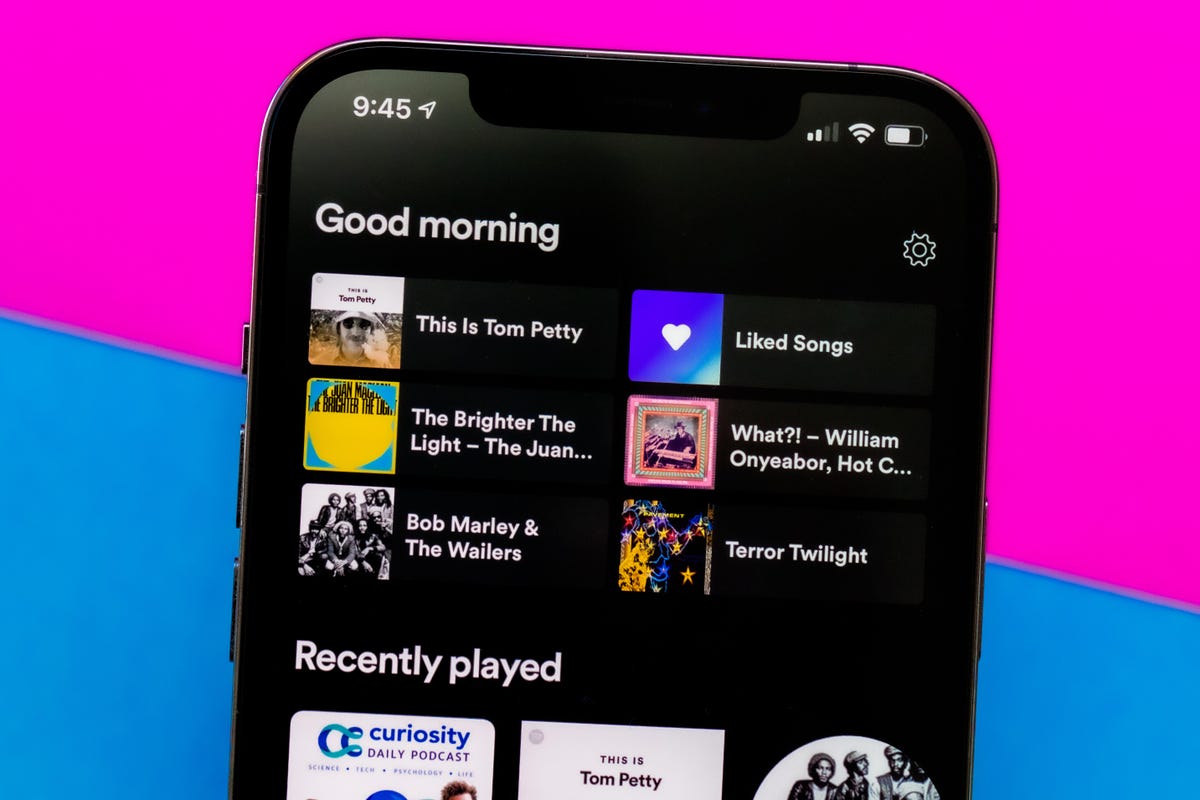
Adjusting these settings can really make your music pop
James Martin/CNETAdjust the quality of your music for a clearer sound
You can also adjust the audio quality of your music. This is handy if you're using mobile data and don't want to bump up your phone bill. Reducing the audio quality will use less data.
Here's how to change the audio quality on mobile and tablet:
1. Open the Spotify app.
2. Tap the gear icon to access Settings.
3. Scroll down until you see the heading Audio Quality -- not under Data Saver.
4. Under WiFi streaming and Cellular streaming, you can select Low, Normal, High or Automatic. The Automatic option adjusts the audio quality to whatever your signal strength is. There is also a fifth option for paid subscribers called Very high.
How to change the audio quality on your desktop:
1. Open Spotify.
2. Click the down arrow in the top-right corner.
3. Click Settings.
4. Scroll down to Audio Quality.
5. Beneath Audio Quality you should see Streaming quality. Click the drop-down menu to the right.
6. Choose between Low, Normal, High or Automatic options, and the Very high option for paid subscribers.
For more information on Spotify, see which Spotify plan is best for you and how Spotify stacks up against Apple Music.
Source
Tags:
- 3 Spotify Audio Settings That All 188 Million Subscribers Free
- 3 Spotify Audio Settings That All 188 Million Subscribers Youtube
- 3 Spotify Audio Settings That All 188 Elements
- 3 Spotify Audio Settings That All 188 Npc
- 3 Spotify Audio Settings Iphone
- 3 Spotify Audiobooks
- 3 Spotify Audio Editor
- Love Scars 3 Spotify Code
- Cette 3 Spotify
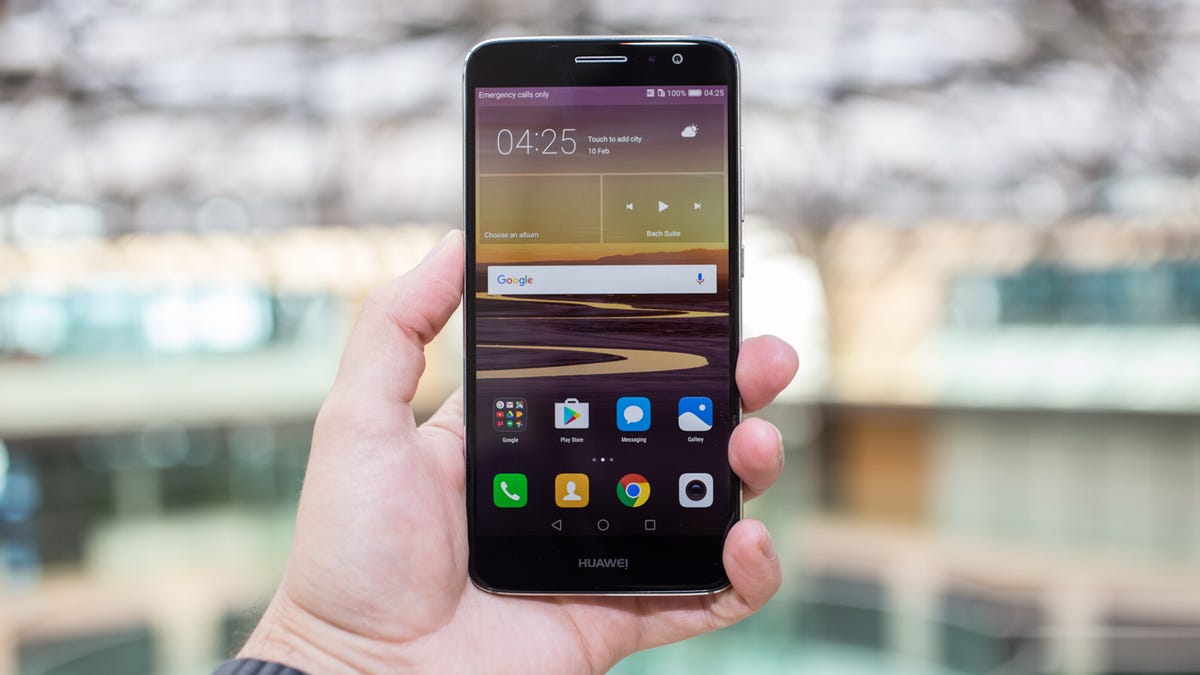
Huawei Nova review: Huawei hopes Nova and Nova Plus will be shining stars of the midrange phone market
Huawei is taking a new whack at the midrange with two freshly unveiled devices, the Nova and Nova Plus.
In Latin, "nova" means "new", and this is indeed a new start for Huawei in terms of its very strait-laced and technical naming conventions of phones past. In astronomy terms though, novas are exploding stars, and it's debatable whether these phones, as polished and well-rounded as they are, will set the world alight, aimed as they are at the busy middle of the market.
The smaller Nova has a 5-inch screen, while the larger Nova Plus (sadly not Supernova) supersizes with a 5.5-inch display. Cast in Huawei's signature sand-blasted aluminium, the pair have slightly rounded backs that allow them to nestle neatly in your palm. Add together full HD displays, octa-core Snapdragon processors and USB Type-C charger ports, Huawei really has left no key feature wanting when kitting out the Nova range.
Each phone also has an option for filtering out blue colours from the displays -- similar to the iPhone's Night Mode, other Huawei phones and Samsung's Galaxy Note 7. Plus you can double tap on the screen with your knuckles to take a screenshot, a feature that's also on other Huawei phones.
Aside from their slight size difference, the best way of telling them apart is by flipping them over. On the rear the Nova has a round camera set into the top corner of the chassis with a matching circular fingerprint sensor. The Nova Plus, on the other hand, has a more centred square camera module that protrudes from the device with a square fingerprint sensor positioned directly below it.
The Nova's main camera is slightly bigger than the Nova's (16 vs. 12 megapixels) with the forward-facing counterparts measuring in at 8 megapixels on both phones. The primary camera modules are capable of face detection focus and contrast focus, as well being able to capture 4K video.
Design differs on these sibling phones.
Andrew Hoyle/CNETThe camera software also features Huawei's own selfie enhancement tools, with some tweaks that allow you to add more realistic makeup, with contouring to fit the skin, lipsticks and eyeliner effects. Kim Kardashian, eat your heart out.
Rumour has it that Huawei designed these phones with female buyers in mind. The company did not confirm this, but did say that it expected "slightly more" women to buy the phone than men.
On top of Google's Android Marshmallow software sits a version of Emotion UI, Huawei's customised Android skin. This edition includes a variety of themes designed specifically for the Nova range. Each version of the phone, which is available in gold, rose gold, silver and grey, has its own dedicated theme that provides colour continuity across hardware and software, but several other choices also come preinstalled. They have names such as "feather", "sweet" and "wind" and feature ethereal, pastel-hued scenes, with icons to match.
The Nova and Nova Plus will be available in Europe, the Middle East and Asia within the next two months. Dual-SIM versions will be available, depending on the region, and both will be available as 32GB models with expandable storage. Only European pricing has been announced: 399 euros for the Nova and 429 euros for the Nova Plus, which converts to $445, £335 or AU$590, and $480, £360 or AU$635 respectively. US availability is yet to be confirmed.
Huawei Nova: Specs and key features
- 5-inch full HD display
- Fingerprint scanner
- 12-megapixel main camera, 8-megapixel front camera
- USB Type-C
- Octa-core Snapdragon 625 2GHz processor
- 3GB RAM
- 32GB storage, expandable by 128GB with microSD card
- Android Marshmallow
- Dual SIM version in some regions
- 3,020 mAh battery
- 146 grams (5.15 ounces)
Huawei Nova Plus: Specs and key features
- 5.5-inch full HD screen
- Fingerprint scanner
- 16-megapixel main camera with optical image stabilisation, 8-megapixel front camera
- USB Type-C
- Octa-core Snapdragon 625 2GHz processor
- 3GB RAM
- 32GB storage, expandable by 128GB with microSD card
- Android Marshmallow
- Dual SIM version in some regions
- 3,340 mAh battery
- 160 grams (5.64 ounces)
Source
Tags:
- Huawei Nova Review Huawei Hopes Nova And Nova Plus Socks
- Huawei Nova Review Huawei Hopes Nova And Eddie
- Huawei Nova Review Huawei Hopes Nova And Jasmine
- Huawei Nova Review Huawei Hopes Nova And Mom
- Huawei Nova Review Huawei Hopes Cookies< /a>
- Huawei Nova Review Huawei Hopesource
- Huawei Nova 9 Se Review
- Huawei Nova Y70 Review
- Huawei Nova 9 Se Camera Review

FEMA grants, SBA loans: How to get government help to rebuild after a natural disaster
This story is part of The Cost of Climate Change, CNET's coverage of how the changing climate impacts a range of financial issues.
As climate change brings severe weather to more regions of the US, a growing number of homeowners and residents are dealing with natural disasters for the first time. If your home or vehicle has been flooded, damaged by hail or set ablaze, there are resources to help.
In the US, the federal government provides various forms of assistance to rebuild homes and restore personal property in the wake of a natural disaster. Some of it comes as grants, which is money you don't have to repay. But most of it comes through loans, which you do have to repay -- with interest.
Here's a breakdown of the major forms of federal assistance programs when recovering from a disaster and what you'll need to apply.
Federal Emergency Management Agency grants
FEMA's disaster assistance programs are designed to aid homeowners "who have uninsured or under-insured necessary expenses and serious needs," according to the agency's website. The Individuals and Household Program, which helps homeowners rebuild both the exterior and interior of their homes, is capped at around $30,000 to $35,000, according to Mark Friedlander, director of corporate communications at the Insurance Information Institute.
Experts suggest not to rely solely on FEMA grants following a natural disaster, however. FEMA grant payouts are "typically well below $10,000," said Friedlander. This, combined with the fact that the grant review and approval process can take a long time, means that homeowners should have other safeguards -- namely, insurance -- in place before a disaster strikes.
"Don't expect FEMA to bail you out from a flood loss or property loss," Friedlander said. "FEMA emergency funds are not a replacement for insurance coverage, for flood insurance or any home loss," Friedlander said.
How to apply for FEMA assistance
Go here to submit an application online. You can also call toll-free at (800) 621-3362 or head to one of FEMA's Disaster Recovery Centers. Here's what you'll need:
- You must file a claim with your insurance carrier before you can apply to FEMA, so be sure to do that first.
- Photos of your damaged home and belongings.
- A list of the damaged and/or lost personal property.
Small Business Administration Loans
The Small Business Administration also offers funding to homeowners and renters who need help with repairs from damages to their home and personal property.
Despite its small business-focused designation, the SBA is actually the primary source of federal funds for long-term recovery assistance for disaster survivors, according to a FEMA representative. The SBA's low-interest disaster loans offer assistance for disaster damage to private property for homeowners, renters and non-farm businesses of all sizes.
In contrast to a FEMA grant, the SBA provides loans, which means you'll have to pay this money back with interest. Your interest rate will depend on whether you can secure credit elsewhere, according to the SBA website. If you can get it from a private lender, the interest rate is capped at 8%. If you can't, your interest rate will not exceed 4%.
Note that these loans are available only if your losses are not covered by your insurance or FEMA funding. Homeowners may apply for up to $200,000 to replace or repair their primary residence and up to $40,000 to replace or repair their personal property, including vehicles.
One thing to keep in mind: If an event is officially designated a natural disaster by the US president or SBA, any loan exceeding $25,000 must be secured with collateral if possible. The SBA also says it "will not decline a loan for lack of collateral," however.
How to apply for SBA loans
Go here to apply for SBA loans. Here's the application and what you'll need:
- Complete and submit IRS Form 4506-C, which allows the IRS to provide tax return information to the SBA.
- Real estate tax information.
- Homeowners and vehicle insurance info and the dollar amount received following a disaster from your insurance carrier.
- If you changed employment within the past two years, the SBA may request that you must provide a copy of your current pay stub. This information must be provided within seven days of the SBA's request.
Source
Tags:
- Fema Grants Sba Loans How To Get Government Help To Pay
- Fema Grants Sba Loans How To Get Government Help To Quit
- Fema Grants Sba Loans How To Get Government Security
- Fema Grants Sba Loans How Do You Know
- Fema Grants For Sba Loans
- Fema Sba Loan Application
- Fema Grants Portal

Don't pull a Rudy Giuliani: Prevent butt-dialing with these 5 tips
I've done it, you've done it, and now the president's lawyer is guilty of it too -- I'm talking, of course, about butt-dialing. Butt-dialing, or "pocket-dialing" as it's called in politer circles, is the result of a perfect storm of bad smartphone habits that starts with forgetting to lock your device. Next you toss your unlocked phone into a pants pocket (often a rear one). Then, as you move around with your unlocked phone shifting in your pocket, taps and bumps combine with static electricity and a bit of moisture to fool your phone's touchscreen into thinking it's being pressed, pinched or zoomed.
From there, it's really just a crapshoot in terms of which app your phone opens or who it decides to call. In Rudy Giuliani's case, the former mayor's phone dialed a reporter Giuliani had recently spoken with. The call went to voicemail, capturing part of a chat between Giuliani and an associate.
Butt-dialing happens to everyone, so here are f ive ways to make sure it's not your behind on the line when it does.

Forgetting to turn off your phone's screen before pocketing it is the first step to an accidental butt-dial.
Angela Lang/CNETLock. It. Up.
If everyone would just remember to hit the power button to turn off their screens before pocketing their phones, we could leave butt-dialing behind us. But I get it -- the whole point of owning a phone is convenience. Thankfully, both iPhones ($500 at Best Buy) and Android phones have an auto-lock setting that can turn your screen off for you. iPhones will turn off their screen and lock the phone in as little as 30 seconds with no activity. Android phones have an even shorter option: 15 seconds.
Depending on how you use your phone, setting auto-lock to 15 or 30 seconds may be more trouble than it's worth. For example, if you read a lot of news or e-books you may find your phone screen going dim before you're finished reading the page you're on. But if you want to avoid the shame of pocket-dialing, you may want to try and adjust the time setting so it works for you.
Here's how to change the aut o-lock or sleep setting on your iPhone or Android:
1. Open Settings.
2. Tap Display or Display & Brightness.
3. Tap Sleep or Auto-Lock or Screen timeout (your phone may call it something slightly different).
4. Choose the shortest interval you feel comfortable with.

Google's new face unlock feature uses a combination of radar and infrared sensors.
Sarah Tew/CNETUse a passcode, fingerprint or facial recognition to unlock
If you don't have a security lock on your phone, set one. Not securing your phone with a security lock can leave you vulnerable to crooks and snoops and makes your phone more likely to unlock itself in your pocket. Adding a passcode or requiring a fingerprint or facial identification to unlock your phone makes butt-dialing practically impossible, so long as you lock your phone before you pocket it.
Here's how to set your phone to require a passcode, fingerprint or facial identification to unlock:
1. Open Settings.
2. Tap Security and lock screen or Touch ID & Passcode or Face ID & Passcode.
3. If you already have a passcode, you may be asked to enter it.
4. Set your phone to require a passcode, fingerprint or facial identification to unlock.

If your digital assistant can be summoned from the lock screen it can also accidentally make calls without your knowledge.
Nicholas Tufnell/CNETGive your digital assistant a break when your phone is locked
Whether you use Siri on iPhone or Google Assistant on Android, it's quite possible your digital assistant is to blame for the occasional butt-dial. If your phone is set to always listen for "Hey, Siri" or "OK, Google," or you can summon either assistant with a button while the screen is locked, your chances of butt-dialing increase exponentially. All it takes is a misunderstood word or phrase or an errant button press and next thing you know your assistant is dialing out.
Here's how to restrict Siri to only respond when your iPhone is unlocked:
1. Open Settings.
2. Tap Siri & Search.
3. Next to Listen for "Hey Siri" turn the toggle off.
4. Next to Allow Siri When Locked turn the toggle off.
Here's how to restrict Google Assistant to o nly respond when your Android phone is unlocked:
1. Launch Google Assistant.
2. Tap the inbox icon in the lower left corner to open Assistant settings.
3. Tap your profile picture in the upper right corner.
4. Tap Assistant on the top menu bar.
5. Scroll all the way down to the Assistant devices section and tap Phone.
6. Next to Access with Voice Match turn the toggle off.
7. Next to Lock screen personal results turn the toggle off.

Clear your recent call history to avoid butt-dialing the people you last spoke to.
Screenshot Clifford Colby/CNETPractice good phone hygiene
As happened with Giuliani, your phone may pocket-dial the last person you spoke to. One way to make sure that doesn't happen is to clear your recent call history. You may especially want to do this if you've recently spoken with, shall we say, sensitive contacts, like your boss, an ex or a political journalist.
Also be sure you don't have anyone saved in your speed-dial or favorites folder to whom a butt-dial might result in negative repercussions. Basically, the easier you make it to call someone, the easier it is for your phone to accidentally call them.
If you have an Android device, you can take an additional step and make sure you have on-body detection turned off. The whole point of on-body detection is to keep your phone unlocked while it's on your person, which is simply an open invitation to butt-dialing.
Here's how to turn off on-body detection on an Android phone:
1. Open Setting s.
2. Tap Security > Smart lock
3. Enter your passcode.
4. Tap On-body detection.
5. Turn the toggle off.
Butt-dials aren't the only modern-day frustration vexing smartphone owners. As the sheer volume of robocalls continues to rise, wireless carriers are starting to address the problem themselves, but in the meantime there's still more you can do to protect yourself. If you're stoked about dark mode on your phone but salty more app developers haven't gotten onboard with it yet, at least Gmail has finally caught up with the dark mode trend. Finally, are you still trying to figure out the right combination of presses, taps and swipes to take a screenshot on your phone? Check out our guide to taking screenshots on any phone.
Originally published earlier this week.
Source
Tags:
- Rudy Giuliani Hands Down Pants
- Rudy Giuliani Suspended From The Bar
- Video Of Rudy Giuliani
- Rudy Giuliani Recent Interview
- Rudy Giuliani Interview Today
- Youtube Videos Rudy Giuliani
- Don T Pull Any Punches
- My Couch Pulls Out I Don T Shirt
- Don Thompson
- Don Tomas Cigars
- Don The Dragon Wilson

Peloton Guide Review: Turn Any TV Into a Guided Strength Workout
The Peloton Guide, which retails for $295, is the latest fitness gadget from Peloton, the fitness brand that made its name with the "It" indoor cycling bike to own. If you're familiar with smart home gyms such as Mirror, Tempo or Tonal, then you know they can be expensive and require an amount of space that isn't always feasible. That's why Peloton created a cheaper, smaller device that uses a camera with AI technology to track your movements during class, so you can get the benefits of having a smart home gym without needing a lot of room.
More specifically, the Peloton Guide is intended to be used with Peloton's strength training classes; it allows you to monitor your form and performance during the sessions. The original Peloton was a pioneer in the world of interactive home workout equipment, but how does the Guide fare as a smart fitness device? I took the Peloton Guide for a spin and had a lot of thoughts about it. Read on to learn about my experience with Peloton's newest gadget.
How we tested
Smart home gyms are still fairly new even though many different brands have come out with their own versions over the last several years. I've tested other smart fitness equipment, but I knew I had to view the Peloton Guide as its own entity since I hadn't tried a device like it before. It's not a traditional smart home gym, since it's so compact and consists only of the camera and AI.
To test the Peloton Guide I looked at these important features:
Setup: Is it easy to set up just by using the instruction manual? Does it work on all TVs? Does a strong Wi-Fi signal matter?
Space: Does the device take up a lot of room? Can you use it in a small space? Can this device capture people of different heights in frame?
Feedback: What unique feedback does this device provide that other smart home gyms can't? Does the feedback seem accurate?
Ease of use: How does it work with Peloton classes and is it easy to follow and understand?
How much does the Peloton Guide cost?
Generally if you purchase a Peloton bike or treadmill you're shelling out somewhere between $1,500 to $3,000 – even with the latest $500 discount. The most basic Peloton Guide package (which just includes the Guide itself), is only $295, making it an appealing option for those on a budget. Right now Peloton is offering customers a 100-day risk-free trial of the Peloton Guide before they commit to purchasing it.
If you want to upgrade to the Guide Strength Starter package, it retails for $545 and includes three sets of Peloton dumbbells (ranging from 5- to 30-pound weights) and a workout mat. The last package, the Guide Power, includes six pairs of dumbbells (ranging from 5 to 50 pounds), a workout mat and a heart rate monitor, retailing for $935 to $1,270 depending on the weights you pick. Keep in mind you don't need to use Peloton-specific dumbbells for these classes. If you have your own weights at home, those will work just as well.
You'll need an All-Access Peloton membership to access classes on the Guide, which is a separate cost. Right now Peloton is offering a deal for Guide-only members with an introductory rate of $24 a month through 2022 -- a discount from the normal $44 per month rate. The All-Access membership lets you set up to five profiles per household on the account. If you already own a Peloton All-Access membership, you can use the same account for the Guide.
How does the Peloton Guide work?
The Peloton Guide is intended to be used in practically any space, as long as you have a TV (sorry, no tablets or phones) with an HDMI port and a 16:9 aspect ratio. The Guide is small enough to fit in most spaces and only weighs 18 ounces. It comes with a remote, HDMI cable, power cable and adapter, as well as a mount. To set up, Peloton recommends placing the Guide on a stable area about 3 to 6 feet from the ground with access to Wi-Fi with an internet speed greater than 3 megabytes per second. The camera should point to a workout space that is unobstructed with enough light in the room.
I placed the Guide on the TV stand in my living room and found it was a relatively easy setup since the camera isn't big. Once you find a spot that works, you can set the Guide on the magnetic mount that holds it in place. What took me the longest was setting up my Peloton account and making sure I was able to sync up the Peloton heart rate monitor (which is optional). The Guide is currently compatible with other Bluetooth heart rate monitors, and will be adding Apple Watch capability in the near future.
The last part I had to do was calibrate the screen through the Guide settings to fit my TV. This is important to note because initially the images on my TV screen looked larger and out of frame than I expected, but calibrating it to fit the screen fixed that issue.
I also had to play around with the camera positioning to make sure it was pointing in the right direction and that it was able to capture my whole body in frame. There's an outline of a box that surrounds you once it views you on the screen. If it can't view you well, the Guide will warn you with a prompt telling you you're out of frame.
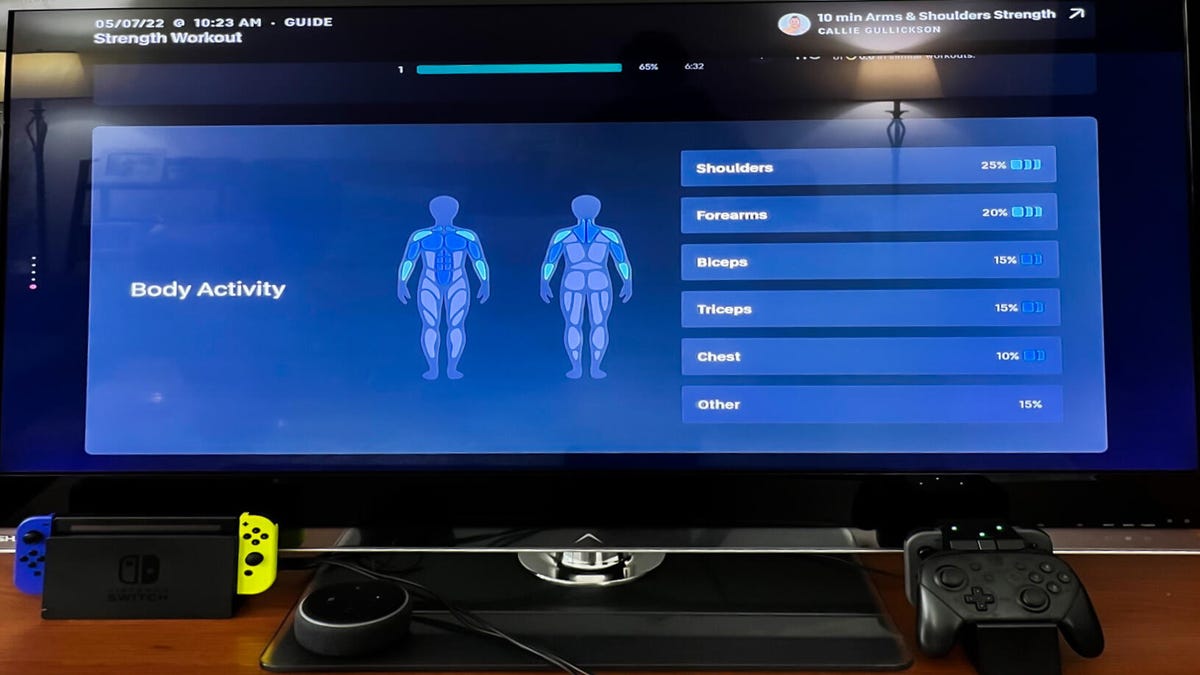
The Body Activity Guide tells you which muscles need rest and which are ready to be worked out.
Giselle Castro-Sloboda/CNETOnce the Guide is up and running, you can select from strength classes on Peloton's roster that are compatible with the Guide. Classes that are meant to be used with the Guide have an icon that resembles a water droplet located on the lower right side. Classes can be selected based on the Body Activity Guide. This guide shows you a silhouette of a body and highlights what muscles you have already worked on in the past seven or 30 days. Based on this, it will suggest classes based on muscle groups you haven't worked on, so you're not exhausting the same body parts each time. The more you work a specific muscle, the bluer it will appear on the body activity guide model.
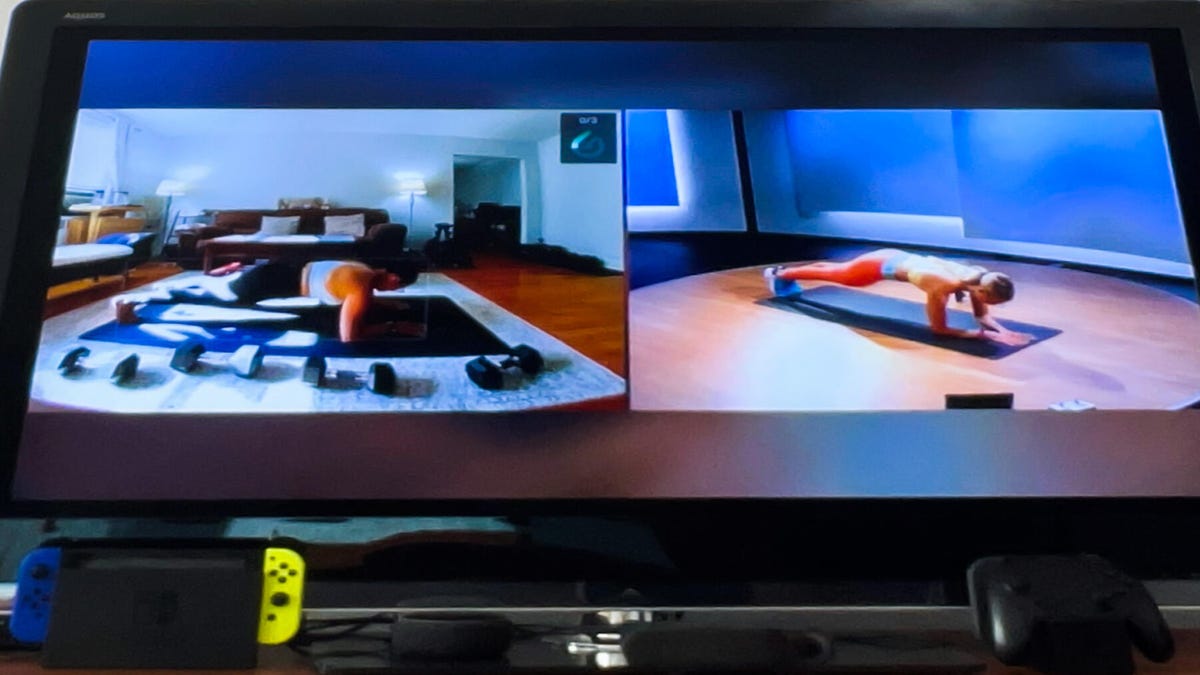
Self Mode through Peloton Guide gives you the option to view yourself side by side with the instructor.
Giselle Castro-Sloboda/CNETOnce you're set on a class, then you have to set up Self Mode. This function allows you to choose how you want to view yourself during class. You have the option to see yourself full screen, with a minimized instructor screen on the left side, or you can set it up the other way around. The last option is to view yourself in a split screen so you are side by side or stacked above with the instructor, which is helpful if you want to make sure your form is on par with theirs. Personally, I found it distracting seeing myself full screen, so I preferred the split screen mode where I could view both myself and the instructor.
If you have any privacy concerns, you'll want to know that the device has a plastic cover that you can slide to conceal the camera when it's not in use.
Space requirements
The good thing about the Peloton Guide is that you don't need a lot of room to use it. At minimum you need 4.5 feet by 6 feet of unobstructed space. For reference, this is about the size of two yoga mats side by side. You should also make sure you can maintain a distance of two to three feet away from your TV. The device is intended to be used by people of all different heights, so finding the stance that works for you is important, otherwise you'll be out of frame.
What it's like to use the Peloton Guide
Taking a class with the Guide is a little different than taking a class without it. The Guide adds its own personal training element by using AI technology to track your movements. This way you can compare your form against the instructor's during class. (Though the Guide itself doesn't have the ability to correct your form.)
Before taking a class, you can view demos of the exercises ahead of time. When you finally start the class, the teardrop-shaped movement icon fills up as it counts how many exercises you complete. This is subject to it capturing you in frame during the exercises – which it didn't always do for me. I also noticed if I took a slightly longer break or moved slower the tracker assumes you're not moving and doesn't fill up the movement icon entirely. This defeats the purpose when strength training is supposed to be done at a slower pace than a cardio-based class. At the end of class, you can see your statistics and how many exercises you completed based on what the Guide was able to capture. The more your movement is tracked throughout a class, the higher the chances you'll earn an awards badge.
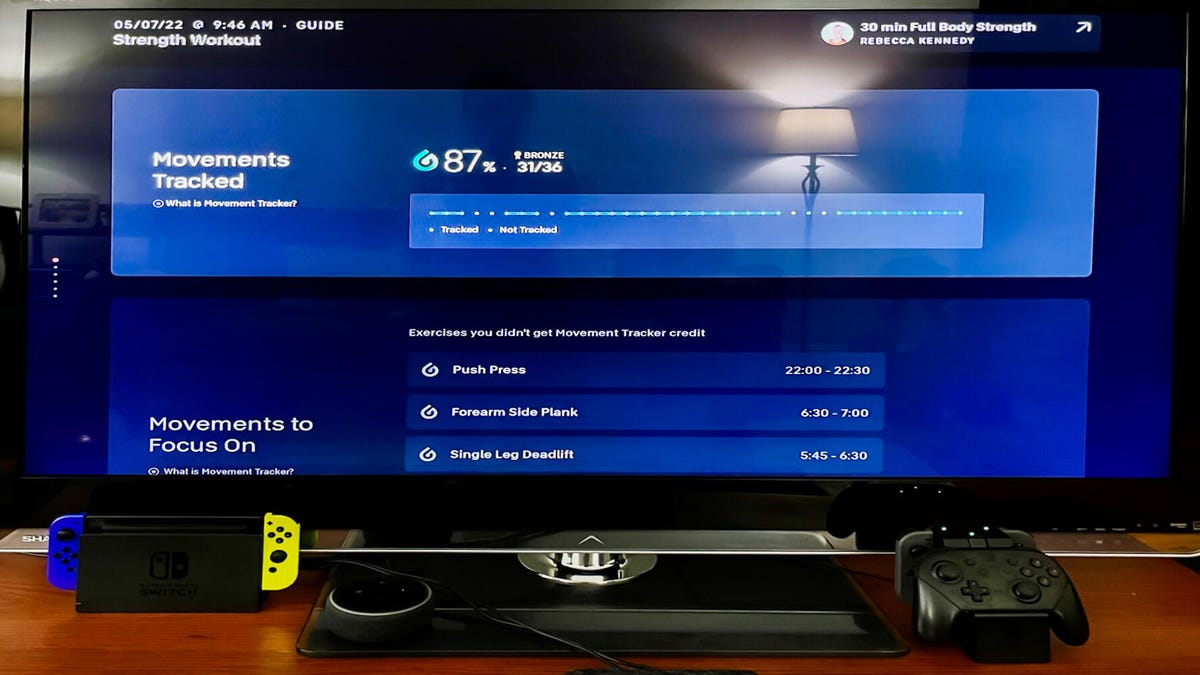
The Movement Tracker lets you know at the end of class how many movements it captured.
Giselle Castro-Sloboda/CNETI personally found the movement tracker to be inconsistent depending on the exercise I was doing. It could've been my error, but I even made sure I was in frame for the camera to see me. This could be distracting for the average user if they're fixated on looking at themselves onscreen instead of focusing on the exercise at hand. For example, when you're doing push-ups, craning your neck to look up at the screen isn't optimal or good for your form.
Workout programs
The Peloton Guide is designed to be used with certain Peloton strength classes instead of its cycling or tread classes. There are three class offerings so far: Floor Bootcamp, taught by instructors Jess Sims and Selena Samuela; Split Programs, which is a four-week program designated to work various muscle groups and Live Guide Classes taught live by instructors.
As someone who enjoys strength training I liked the idea of Peloton coming up with a program that functions like a personal trainer. I think it's a decent start for those who want more of a structure with a strength training program -- the Guide offers just that. The instructors are also good motivators if you need that extra boost and are still learning some strength training exercises.
Pros and cons
As with any piece of fitness equipment, the Peloton Guide has its pros and cons.
Pros
- It fits in just about any space, and is ideal for a living room, basement or apartment.
- It's affordable enough for people interested in trying out Peloton without spending upward of $1,000.
- It can be motivating to have a set strength class schedule that takes out the guesswork for you.
Cons
- There's no way of knowing if you're out of frame during class unless you're looking at the screen the whole time.
- If you're not going at the expected pace, the tracker assumes you're not moving and doesn't fill up the movement icon entirely.
- Novice lifters would benefit more from the Guide if it was able to correct your form, count reps or determine when you should lift heavier.
How the Peloton Guide compares
Although the Peloton Guide is the first AI home gym I've heard of on the cheaper and smaller scale, there are bigger smart home gyms that it will be competing with on the market. The smallest smart home gym I would compare it to is the Tempo Move.
Tempo Move is intended to be a smaller version of the Tempo Studio, and it comes with weights and a small stand for storage. Although Tempo Move costs more than Peloton Guide (it retails at $495) and requires a bit more space, it's still cheaper than the Guide Strength Starter package.
Tempo Move's AI technology is also more advanced than Peloton Guide's because it allows you to use your smartphone and acts more like a personal trainer by correcting your form and letting you know when it's time to increase your weights. I think the Peloton Guide has the potential to be just as good with a few tweaks, and Peloton's spokespeople told me that they plan on evolving the Guide with lots of upcoming feature updates.
Final verdict: Is the Peloton Guide worth it?
If you're somewhere between a beginner and intermediate experienced strength trainer, then you may like the Peloton Guide. Novice lifters will probably not find this device entirely helpful if it isn't helping them know if they're doing an exercise correctly.
Devoted Peloton members who already own the bike or treadmill may not feel like it's necessary to purchase an additional device if they can take the same strength classes through the same membership. A possible feature the Guide could include in the future is being able to read and correct cycling or running form, which would make it a more appealing purchase to existing Peloton bike or tread owners. For example, the Guide could serve helpful for people new to indoor cycling who need help measuring the right height settings for their bikes. Or even making sure that their form is correct during the three different positions used in class. Likewise for people running on the treadmill, the Guide could make sure they maintain decent running form during class.
Although the Peloton Guide is a good start for Peloton to jump into the smart home gym market, I still think it has a few kinks it has to work out as well as features it needs to add to make it comparable to the competition. It's got a lot of potential and I'm looking forward to seeing what new upgrades are added to the Peloton Guide in the near future.
The information contained in this article is for educational and informational purposes only and is not intended as health or medical advice. Always consult a physician or other qualified health provider regarding any questions you may have about a medical condition or health objectives.
Source
Tags:
Blog Archive
-
▼
2022
(148)
-
▼
December
(35)
- Hackers Threaten To Release Symantec Source Code T...
- 9 Great Reads From CNET This Week: Tech Fails, NFT...
- What Is Shrinkflation And What Does It Mean For Yo...
- 3 Spotify Audio Settings That All 188 Million Subs...
- Huawei Nova Review: Huawei Hopes Nova And Nova Plu...
- FEMA Grants, SBA Loans: How To Get Government Help...
- Don't Pull A Rudy Giuliani: Prevent Butt-dialing W...
- Peloton Guide Review: Turn Any TV Into A Guided St...
- Facebook To Meta: A New Name But The Same Old Prob...
- LG Gram 16 2-in-1 (2022) Review: Light, Long Batte...
- Best MacBook For 2022
- 'Thor: Love And Thunder' New Trailer Exposes Chris...
- See A Great White Shark Nibble A Cape Cod Research...
- Nvidia GeForce Now Replaces Founders Subscription ...
- IPhone Won't Get Under-Display Face ID, Camera Unt...
- 2021 Kia Seltos Debuts At LA Auto Show, On Sale Q1...
- Infant Formula Inquiry Launched By FTC
- Keep Your Home Spotless With The Hoover CleanSlate...
- 3 Upgrades Apple Gave The IPhone SE In 2022
- Instagram Promotes Pro-Eating Disorder Content To ...
- 2023 GMC Canyon Is A Mean Off-Road Machine
- 2023 Honda CR-V Hybrid Has Sharper Looks, More Ref...
- The Best Sci-Fi TV Shows On HBO Max
- Would You Spend $10K On NFT Stick Figures? Lots Of...
- Need Better Cell Phone Reception? Try These 10 Tip...
- Sci-fi Screenwriter Gary Whitta Wants Kids To Poop...
- Sonos' Next Speaker Could Be Its 'Best-Sounding' Y...
- Netflix Launches First Mobile Games For Android Gl...
- Samsung's Next Metaverse Move Is A Roblox Game
- Amazon Delivery Drivers Risk Write-ups And Injurie...
- Yes, You Can Use Windows Software On A Chromebook
- Huawei Exceeds 200 Million Smartphone Shipments, S...
- NHTSA Has Phantom Braking Questions For Tesla, Ask...
- The Simpsons At 30: One Big Mistake Cost The Show ...
- Anker Nebula Capsule Pico Projector Review: Phosph...
-
▼
December
(35)
